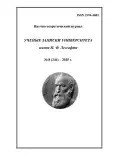PREVENTION OF VAPING ADDICTION IN ADOLESCENTS
- Authors: Kostin A.K.1,2
-
Affiliations:
- Irkutsk State University
- Military Educational and Scientific Centre of the Air Force «Professor N.E. Zhukovsky and Y.A. Gagarin Air Force Academy»
- Issue: No 8 (2025)
- Pages: 5-13
- Section: General pedagogy, history of pedagogy and education
- URL: https://journal-vniispk.ru/1994-4683/article/view/309638
- DOI: https://doi.org/10.5930/1994-4683-2025-5-13
- ID: 309638
Cite item
Full Text
Abstract
Research methods and organization. The following methods were utilized: theoretical analysis of literature, empirical methods (testing, surveys, diagnostics), methods for quantitative and qualitative data processing, and mathematical statistics. The Dembo-Rubinstein self-assessment diagnostics methodology was applied, along with the 'Inclination to Dependent Behavior' methodology (V. D. Mendelovich), a questionnaire developed by V. D. Mendelovich, and the 'Addictive Inclination' questionnaire (V. V. Yusupov, V. A. Korzunin). The study involved students from the 8th grade (both girls and boys).
Research results. The prevalence of vaping among students has been identified, with a proportion of adolescents exhibiting low levels of addiction. It has been noted that nearly half of the students still display moderate addictive tendencies, while more than a quarter show a pronounced inclination towards addictive behavior.
Conclusions. Teenagers generally have an average level of knowledge about vaping, with a tendency towards a low understanding. Most students are poorly informed about the real risks and consequences of using electronic cigarettes. Overall, the sample is dominated by students with an average level of self-esteem; however, in several aspects of self-concept (appearance, peer authority, character), a significant number of teenagers show low scores. The presence of problematic areas in the structure of self-relationship is typical for this age group. According to the diagnostic results of propensity for addictive behavior, there is a predominance in the sample of high risk for the development of chemical addictions (drug and alcohol). Predisposition to behavioral forms of addiction (gaming, sports-music fanaticism) is expressed to a lesser extent, but is also present in a significant part of the students, requiring targeted psychological-pedagogical work.
About the authors
Aleksandr Konstantinovich Kostin
Irkutsk State University; Military Educational and Scientific Centre of the Air Force «Professor N.E. Zhukovsky and Y.A. Gagarin Air Force Academy»
Email: kostin.ak1958@gmail.com
Pedagogical Institute of Irkutsk State University, doctor of pedagogical sciences 2008
References
- Прелова В. Э. Оценка информированности молодежи о механизмах токсического воздействия вейпинга на организм человека // Мечниковские чтения-2023 : сборник материалов конференции. 96-я Всероссийская научно практическая конференция студенческого научного общества с международным участием. Санкт-Петербург : Северо-Западный государственный медицинский университет имени И. И. Мечникова, 2023. С. 95–96. EDN: SMKKKU.
- Лосева Т. К. Вейпинг в подростковой среде: сущность, причины, профилактика // Научные исследования 2024 : сборник статей X Международной научно-практической конференции. Пенза : Наука и Просвещение (ИП Гуляев Г.Ю.), 2024. С. 125–128. EDN: UEVOME.
- Шаршнева В. В. Профилактика вейпинга среди подростков // Актуальные вопросы развития социальной и образовательной сфер : сб. ст. Витебск : Витебский гос. ун-т им. П.М. Машерова, 2024. С. 121–124.
- Прихожан А. М. Диагностика подросткового возраста. Москва : АНО ПЭБ, 2007. 56 с. ISBN 978-5-89774-998-0.
- Менделевич В. Д. Психология девиантного поведения. Москва : Городец, 2016. 385 с. ISBN 978-5-906815-94-1.
- Юсупов В. В., Корзунин В. А. Психологическая диагностика зависимого поведения. Санкт-Петербург : Речь, 2007. 123 с. (Психологический практикум). ISBN 5-9268-0576-7.
Supplementary files








